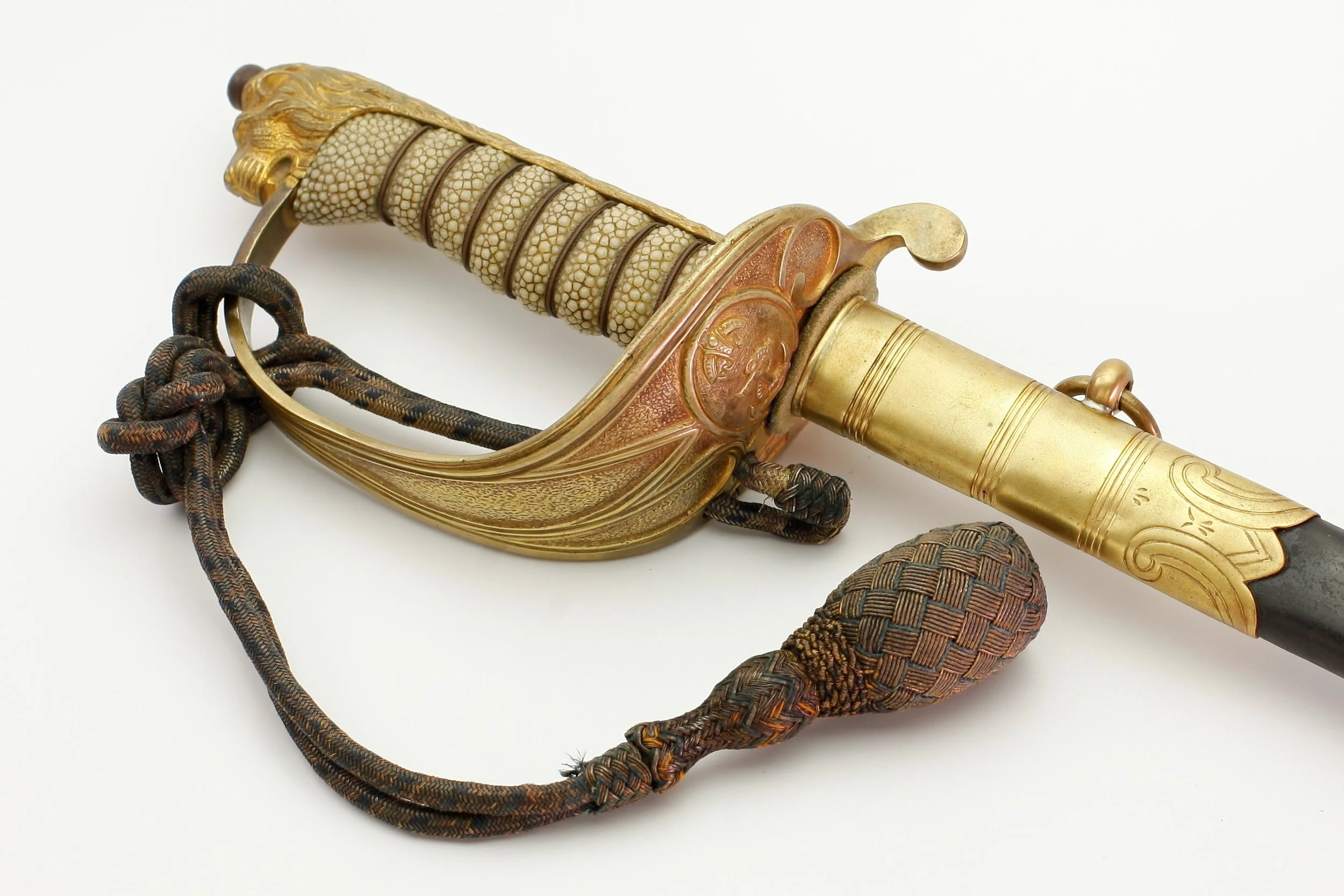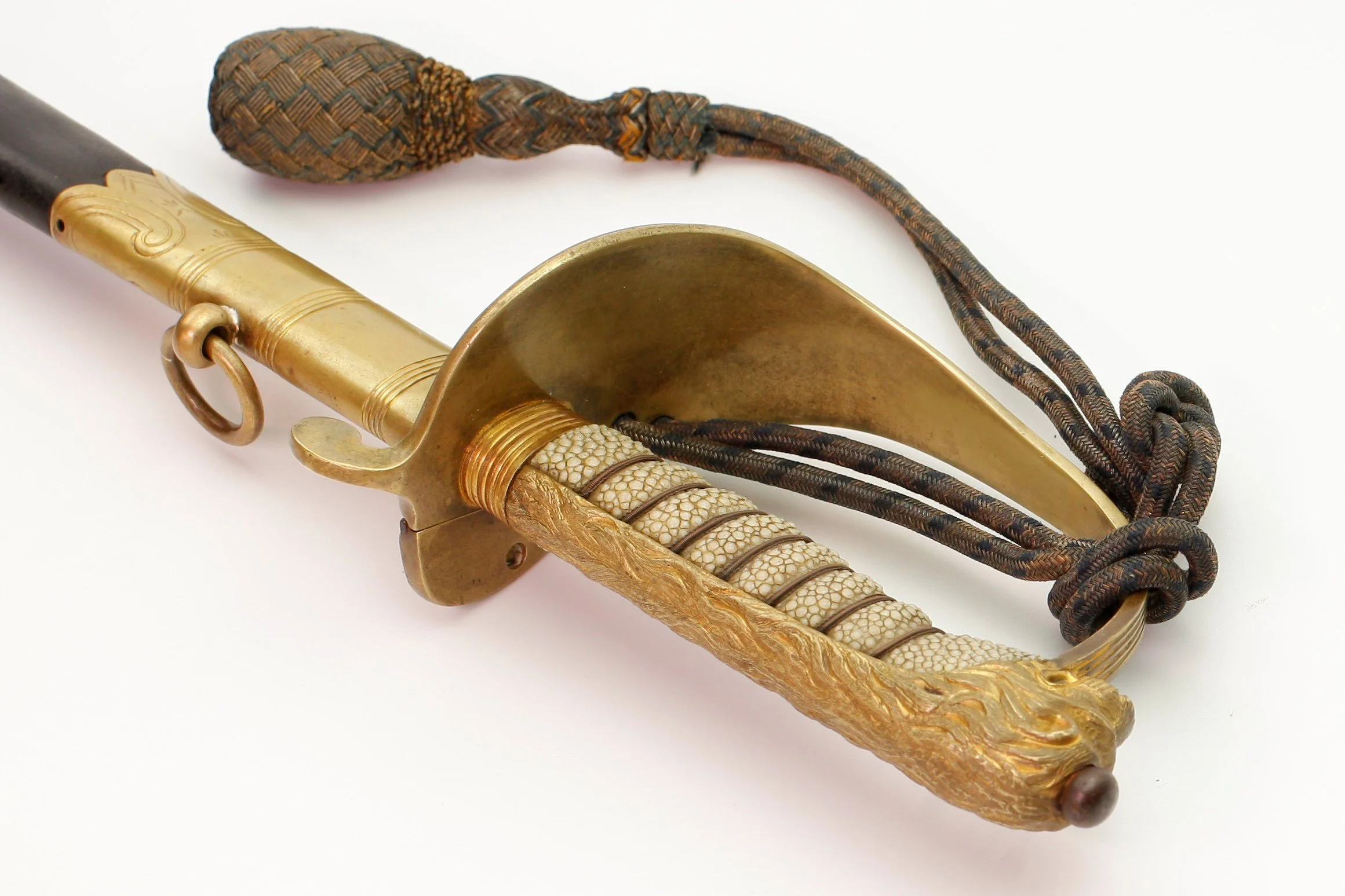Identifying Royal Navy Swords
This article is sponsored by Thierry the Sword Guy. If you’d like to buy an antique weapon of your own then click the link and browse Thierry’s extensive sales catalogue.
Royal Navy officers of HMS Sutlej, somewhere on the Pacific Station, circa 1866.
The Royal Navy during the Victorian period played a significant role in shaping our modern world. Thanks to its never-before-seen dominance of the high seas it all but eradicated the pirate activity that had plagued the trade lanes for a thousand years, helped to bring about an end to slavery and opened up new commercial markets between all manner of nations.
It was an interesting technological period too, one that saw the Navy master the Age of Sail, experiment with steam propulsion and metal hulls, and, finally, it watched as the last of the canvased ships of the line fell to obsolescence. The swords of the era are just as fascinating as the hardy men who carried them and so I felt that a handy, simple reference guide would be just the ticket for my fellow scholars. Due to the individualism of the officers and the nuances of the sword makers and retailers, there can be differences between two swords of the same pattern and the decoration of scabbards and placements of suspension rings also oscillated frequently. Hopefully, this brief guide helps to clear the muddy waters a little.
If you have any more details to add or any corrections you feel are worth making then please leave a comment. Thank you for reading.
Matthew Forde
The 1805 Pattern Sword
This was the first pattern introduced by the Royal Navy. Before this, officers were relatively free to wear whatever sword took their fancy as long as their superiors didn’t take umbrage, and there was little distinction between a sword meant to be carried in land-based warfare and that for the high seas. Hangers, cutlasses and smallswords abounded with some officers choosing to have ornamented swords for dress occasions and an entirely different (usually more robust) sword for hand-to-hand combat. The 1805 Pattern Sword was introduced to impose some degree of consistency on these weapons. The Pattern had two types: one for senior officers of commander and above, and the other for both the junior ranking officers and those that held warrants rather than commissions. Both types had single-edged, straight blades marked with a royal cypher, trophies of arms and nautical symbology. Hilts were of the ‘stirrup’ type with rounded langets that projected down over the blade’s ricasso. Senior officers splashed out on lion’s-head pommels, ivory grips wrapped with gilded wire, blued blades, and ornate scabbard mountings; while juniors had to endure plain pommels, non-blued blades and dark grey shagreen grips. In 1825, the senior version of the Pattern was adopted for all officers, leaving only midshipmen and warrant officers to carry the junior.
Clearly, due to the variety of surviving examples with non-spadroon blades, some officers serving during the introduction of the 1805 Pattern Sword chose to retain their pre-regulation blade and marry it to the new stirrup hilt.
The 1827 Pattern Sabre
The year 1827 ushered in an updated design for the officers’ sabre. Based on the British Army’s 1822 Pattern Sabre, the new sword had a gilt-brass hilt of ‘Gothic’ flair forming a half-basket and presenting an oval cartouche containing a fouled anchor and crown. The blade was of the pipe-back type, ending in a quill point and sometimes incorporating a large, flared cutting edge to the rear of the blade’s final third or quarter. The grip was covered in large-nodule white shagreen: dark shagreen still denoting warrant officers’ ownership.
Whether the knuckle-bow entered the lion’s-head pommel through the mouth or under the chin seems to have been a manufacturer’s preference though debate continues regarding this point and some collectors insist the under-chin variant only came along after 1901. The short lion’s mane of the 1805 Pattern’s back-strap seems to have been eschewed by having a longer one in this period. A single slot in the knuckle-bow (near to the pommel) was provided for the sword knot to be tied to and then, from around 1830, a ring for it was often attached to the handle’s ferrule. The two holes in the guard were introduced in the late 1830s and are now familiar staples of the model. The black leather scabbard had three gilt-brass mounts: a locket, middle and a chape. The two suspension rings were attached to the first two sections.
The 1846 Pattern Sabre
This pattern was identical to the 1827 Pattern Sabre described above except for the fullered ‘Wilkinson’-type blade that replaced the pipe-backed design. Debates had sprung up regarding the martial merits of the pipe-back blade-forms and, in 1845, the Army had chosen to adopt a single-fullered type put forward by the famous English sword cutler Henry Wilkinson of Pall Mall. The Navy obviously deemed the new blade preferential and chose to take it on, too.
The new blade measured around 79cm long and it was 3.5cm wide at the ricasso. Several minor alterations occurred during the following century, including:
In 1847 the blade became 2.85cm wide at the ricasso.
In 1856 the blade returned to a width of 3.5cm.
In 1880 a scabbard-to-hilt locking pin was introduced though this system can also be found in earlier examples.
In 1891 the blade’s width once again became 2.85cm.
In 1929 the blade’s dimensions were drastically reduced to between 1.6cm and 2.2cm wide at the ricasso.
Initially, the scabbard was the same as that of the previous version’s, being black leather with three gilded brass mounts. This changed in 1847 when the middle mount was deleted and its ring moving to the 10.2cm-long locket section, opposite to the first ring. The year 1856 saw the two rings move back to occupy the same side.
An 1831 Pattern Mameluke
In 1918 the warrant officer’s pattern changed to the same as that of the commissioned officer: a white grip and a lion’s-head pommel, leaving only the master-at-arms to have the dark grey shagreen and a plain pommel, that is until 1970 when warrant officers were re-introduced and given back the dark-handled sword.
From 1842, flag officers (and, reportedly, some members of the aristocracy) carried a mameluke-style sabre with an ivory grip. This type of sword had come from the 1831 Pattern General Officer’s Sword of the Army and, before that, Lord Wellington and the Egyptian campaign of the Georgian period. The navy version differed from the 1831 Pattern by having crown-shaped quillons and a fouled anchor in place of the sword-and-baton on the cross-piece. Few men rose to the rank of flag officer so their swords are scarce and made scarcer by the fact that the pattern was discontinued in 1856, though it lingered in service on rare occasions. The scabbard was made from black leather with gilt-brass mounts.
The year 1856 saw the introduction of the rather iconic dirk for the midshipmen. Before this, midshipmen could purchase a sword as their sidearm with some choosing to buy what was, essentially, a smaller version of the 1846 Pattern Sabre, the change in dimensions meant to accommodate their shorter heights. After 1856, the dirk was to incorporate a lion’s-head pommel, white shagreen grip, a straight blade and two quillons. The blade was lengthened in 1879 to about 45cm and the oval cartouche with its anchor motif was introduced to the cross-guard. Since the start of World War One, the dirk has not been used though it doesn’t seem to have been officially deleted.
Image credit: Terry Roberts
A master at arms’ sabre. One of the rarest of British Royal Navy swords, this example can be seen with a Saint Edward’s crown in its cartouche.
The Tudor Crown that appears on swords of the Victorian era was replaced in 1901 by the Crown of Saint Edward before making a come-back in 1952 when Her Majesty Queen Elizabeth II became monarch. The presence of these designs can aid in dating certain swords.
Some swords feature letters denoting which branch of service their officers joined:
CG: Coast Guard
RNR: Royal Navy Reserve
RNVR: Royal Navy Volunteer Reserve
RNVSR: Royal Navy Volunteer Supplementary Reserve
RDB: Royal Dockyard Battalion
RNAV: Royal Navy Artillery Volunteers
RNAS: Royal Navy Air Service
EIC: East India Company
If this free article was useful then please consider supporting me on Patreon. By adding your support you gain access to a growing archive of useful articles, in-depth resources and advice, personal help with identifications and restorations, and, as I’m slowly liquidating my collection, early access to new sales. You can help out from as little as £1 (or $1) and everything helps. Thank you for your consideration.











